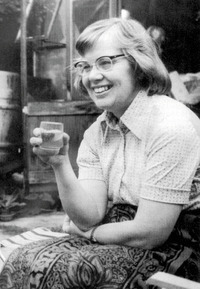Mary Lyon (1943)
 Mary Lyon was one of the most important yet little known geneticists of the 20th century, whose work began a fundamental shift in the way we understand genetic disease. This influential career began serendipitously at KEHS.
Mary Lyon was one of the most important yet little known geneticists of the 20th century, whose work began a fundamental shift in the way we understand genetic disease. This influential career began serendipitously at KEHS.
Mary Francis Lyon was born in Norwich on May 15th 1925. The daughter of a civil servant and a school mistress, she and her two siblings spent much of their childhood moving between cities. The Lyons moved to Birmingham in the mid-1930s and Mary started at KEHS shortly afterwards. Always a gifted and thoughtful student, it was not long before her talents were recognised and she earned one of our essay prizes. Mary recognised this simple gift as the starting point of her eminent career; a set of four books on nature that sparked her lifelong interest in biology and genetics.
Mary went from KEHS to Girton College, Cambridge, in 1943 to read Zoology, Physiology and Biochemistry. As the university did not allow women full membership until 1948, Mary left with a ‘titular’ degree. She was one of just 500 women in a college of 5000 men. She subsequently moved to Edinburgh where she earned her PhD with a thesis on genetic balance defects that she noticed in a mouse. She named this mouse Twirler – a sign of the good humour and charm which were two of Mary’s most memorable characteristics.
Mary studied mice for the majority of her working life. In the late 1950s, Mary was part of a team at the Medical Radiobiological Research Unit in Harwell when she noticed a mutant gene specific to the X chromosome. In 1961, she proposed the theory of X chromosome inactivation. She suggested that one of the two X chromosomes in the cells of mammalian females is randomly inactivated in the early stages of embryo development. This process, which later became known as ‘lyonization’, had huge implications in the way we understand the passing of genetic conditions and how their symptoms become expressed. For example, diseases like Duchenne muscular dystrophy and haemophilia are caused by mutations on the X chromosome. Women are generally protected from such ailments as they have two X chromosomes, whilst men remain affected. However, lyonization explains that women carriers can display some symptoms. For example, women carriers of the haemophilia mutation might bruise more easily or bleed more. This was one of the earliest examples of epigenetic phenomena, where changes in the way genes are expressed are caused by non-genetic factors rather than alterations in the DNA itself.
Mary was also a forward-thinking woman. It is her foresight to which we owe the extensive collection of catalogued mouse embryos at Harwell. Essentially a genetic library, this collection of cryogenically frozen samples is a hugely important resource for geneticists across the globe.
Over the course of her career, Mary amassed a huge number of awards and honours. These include the Royal Society Medal in 1984, the Wolf prize for medicine in 1996 and the Pearl Meister Greengard prize in 2006. Last year, the UK Genetics Society created the Mary Lyon medal in her honour. Other eminent scientists in the field have remarked that it is a wonder that she was not awarded a Nobel Prize.
Mary remained active in her later years. She was required to retire because of her age in 1990, but continued working at the university and attending lectures until 2012. Mary had a remarkable passion for learning that underpinned her whole life and said she would gladly have her time again to continue her work. In a personal history of her first 50 years of research, Mary remarked that this was just the “hors d’oeuvres and the feast is yet to come”.
